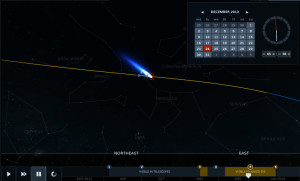 For those hoping to get a good look at comet ISON as it makes its way back into deep space, after its plunge close to the sun, a new ISON computer simulation is available for free to use. We have included the Comet ISON tracking simulator below in this article.
For those hoping to get a good look at comet ISON as it makes its way back into deep space, after its plunge close to the sun, a new ISON computer simulation is available for free to use. We have included the Comet ISON tracking simulator below in this article.
The Comet ISON interactive model was developed by Michal Sadlon and his team at Inove Virtual Environments (www.inove.eu.com). Experienced creators of online space models, the group recently launched their Comet ISON interactive model at: www.solarsystemscope.com/ison to highlight what was hoped to be one of the most spectacular comets visible to the naked eye in decades.
We were fortunate enough to have permission to embed the interactive comet simulation below for our readers:
The ISON computer tracking model visualizes current position of comet, assumed trajectory and all important moments. Users can move forward or back in time to see ISON’s path around the sun.
The view can be se to see the comet from space, or changed to see where the comet appears overhead in the night sky. This is very useful to help individuals find out where and when to look to see Comet ISON in the sky.
Using the interactive computer model, is appears that the next best viewing opportunity to see ISON will begin on the morning of December 7th, and continue for several days thereafter.
ISON will be visible in the early morning hours by looking to the east, just before sunrise. On the 7th, ISON will rise around 5am, just about an hour before the sun, almost due east and low in the sky.
 As the days progress, ISON should be visible slightly earlier each day, and moving more each day toward the northeast. This is because ISON will be moving farther away from its flyby of our Sun which occurred last week.
As the days progress, ISON should be visible slightly earlier each day, and moving more each day toward the northeast. This is because ISON will be moving farther away from its flyby of our Sun which occurred last week.
As some had feared, it appears that ISON did break apart somewhat as it passed the Sun, but it also appears that there should be enough of the 3 mile wide comet still intact to give viewers on the ground something worth looking at.
![Herbal Reference Substances are Key to Everyday Products <!-- AddThis Sharing Buttons above -->
<div class="addthis_toolbox addthis_default_style " addthis:url='http://newstaar.com/herbal-reference-substances-are-key-to-everyday-products/3512112/' >
<a class="addthis_button_facebook_like" fb:like:layout="button_count"></a>
<a class="addthis_button_tweet"></a>
<a class="addthis_button_pinterest_pinit"></a>
<a class="addthis_counter addthis_pill_style"></a>
</div>When it comes to quality control testing and the development of new products, Botanical Reference Materials (BRMs), also known as Herbal References are critically important. To help companies ultimately obtain all-important FDA approval, the Food and Drug Administration provides in its guidance a recommendation that […]<!-- AddThis Sharing Buttons below -->
<div class="addthis_toolbox addthis_default_style addthis_32x32_style" addthis:url='http://newstaar.com/herbal-reference-substances-are-key-to-everyday-products/3512112/' >
<a class="addthis_button_preferred_1"></a>
<a class="addthis_button_preferred_2"></a>
<a class="addthis_button_preferred_3"></a>
<a class="addthis_button_preferred_4"></a>
<a class="addthis_button_compact"></a>
<a class="addthis_counter addthis_bubble_style"></a>
</div>](http://newstaar.com/wp-content/uploads/2021/02/Achillea_millefolium_flowers-100x100.jpg)
![Quality Electrochemical Biosensors are Critical for Medical, Food and Chemical Industry <!-- AddThis Sharing Buttons above -->
<div class="addthis_toolbox addthis_default_style " addthis:url='http://newstaar.com/quality-electrochemical-biosensors-are-critical-for-medical-food-and-chemical-industry/3512086/' >
<a class="addthis_button_facebook_like" fb:like:layout="button_count"></a>
<a class="addthis_button_tweet"></a>
<a class="addthis_button_pinterest_pinit"></a>
<a class="addthis_counter addthis_pill_style"></a>
</div>A number of industries have, at their core, a need to frequent or even continuous analysis of biological media. These include the medical and pharmaceutical fields, biotech firms, and food and chemical companies. To maintain quality standards and develop new products, these industries rely heavily […]<!-- AddThis Sharing Buttons below -->
<div class="addthis_toolbox addthis_default_style addthis_32x32_style" addthis:url='http://newstaar.com/quality-electrochemical-biosensors-are-critical-for-medical-food-and-chemical-industry/3512086/' >
<a class="addthis_button_preferred_1"></a>
<a class="addthis_button_preferred_2"></a>
<a class="addthis_button_preferred_3"></a>
<a class="addthis_button_preferred_4"></a>
<a class="addthis_button_compact"></a>
<a class="addthis_counter addthis_bubble_style"></a>
</div>](http://newstaar.com/wp-content/uploads/2020/10/Electrochemical-Biosensor-100x100.jpg)
![Company Develops Industrial Mixers Well-Suited for both Fragile and Explosive Products <!-- AddThis Sharing Buttons above -->
<div class="addthis_toolbox addthis_default_style " addthis:url='http://newstaar.com/company-develops-industrial-mixers-well-suited-for-both-fragile-and-explosive-products/3512071/' >
<a class="addthis_button_facebook_like" fb:like:layout="button_count"></a>
<a class="addthis_button_tweet"></a>
<a class="addthis_button_pinterest_pinit"></a>
<a class="addthis_counter addthis_pill_style"></a>
</div>Industrial drum mixers are normally applied to blend mixes of varying viscosities such as adhesive slurries or cement. Some of these mixers have the capability of blending mixes of very different particle sizes such as fruit and ice cream, and gravel and cement slurry. The […]<!-- AddThis Sharing Buttons below -->
<div class="addthis_toolbox addthis_default_style addthis_32x32_style" addthis:url='http://newstaar.com/company-develops-industrial-mixers-well-suited-for-both-fragile-and-explosive-products/3512071/' >
<a class="addthis_button_preferred_1"></a>
<a class="addthis_button_preferred_2"></a>
<a class="addthis_button_preferred_3"></a>
<a class="addthis_button_preferred_4"></a>
<a class="addthis_button_compact"></a>
<a class="addthis_counter addthis_bubble_style"></a>
</div>](http://newstaar.com/wp-content/uploads/2020/06/bandeau-sofragir2-100x100.jpg)